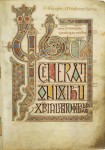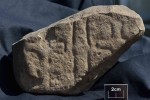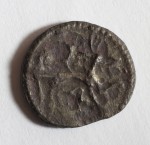 The monastery of Lindisfarne, famous for the beautiful illuminated gospel made around 700 AD that bears its name and as the landing place of the first Viking raiders in 793, was founded in 7th century by Irish missionary Saint Aidan. King Oswald of Northumbria had been raised and educated at the monastery on the island of Iona, so when he was crowned in 634, he invited Iona to send one of its monks to convert the people of Northumbria. Aidan chose Lindisfarne as the location for a monastery that would become the uncontested epicenter of Christianity in Northumbria for the next 30 years and whose influence would spread throughout northern England.
The monastery of Lindisfarne, famous for the beautiful illuminated gospel made around 700 AD that bears its name and as the landing place of the first Viking raiders in 793, was founded in 7th century by Irish missionary Saint Aidan. King Oswald of Northumbria had been raised and educated at the monastery on the island of Iona, so when he was crowned in 634, he invited Iona to send one of its monks to convert the people of Northumbria. Aidan chose Lindisfarne as the location for a monastery that would become the uncontested epicenter of Christianity in Northumbria for the next 30 years and whose influence would spread throughout northern England.
The Vikings, first from Norway and then Denmark, attacked and plundered Lindisfarne repeatedly in the century after the first lucrative foray. Finally in 875 with the collapse of the kingdom of Northumbria under the pressure of a Danish invasion, the monastic community of Lindisfarne picked up stakes and ran. A second monastery was built on Lindisfarne more than 200 years later by the Normans. It stood until Henry VIII’s Dissolution of the Monasteries in 1536.
Despite its outsized importance to the history of Christianity, the precise location of the first monastery was lost. In 1999-2000, there were a few small-scale archaeological surveys in advance of construction on the island, but nothing concrete was discovered. In 2012, University of Durham archaeologist Dr. David Petts carried out a geophysical survey of Lindisfarne funded by National Geographic. The survey discovered several areas of interest with remains that could be related to the first priory.
 Funding for a follow-up excavation was not forthcoming, so this year Petts partnered with archaeological crowdsourcing concern DigVentures to raise the money for an archaeological dig on Lindisfarne, the first to specifically target the Anglo-Saxon priory. The project raised £25,000 in less than a week, plus much-needed manpower from donors who were keen to help excavate the site. Excavations began in June.
Funding for a follow-up excavation was not forthcoming, so this year Petts partnered with archaeological crowdsourcing concern DigVentures to raise the money for an archaeological dig on Lindisfarne, the first to specifically target the Anglo-Saxon priory. The project raised £25,000 in less than a week, plus much-needed manpower from donors who were keen to help excavate the site. Excavations began in June.
 The team found several artifacts that indicated they were on the right track. There was a fragment of a sculpture carved with lines and crosses. A fragment of a bone comb was the first datable artifact. It’s an Ashby Type 8b comb, which dates it to between 900 and 1000 A.D. Another datable find was even closer to the target period: a sceat, an Anglo-Saxon silver coin with an animal on one side and the name of King Eadberht of Northumbria (r. 737-758) on the other.
The team found several artifacts that indicated they were on the right track. There was a fragment of a sculpture carved with lines and crosses. A fragment of a bone comb was the first datable artifact. It’s an Ashby Type 8b comb, which dates it to between 900 and 1000 A.D. Another datable find was even closer to the target period: a sceat, an Anglo-Saxon silver coin with an animal on one side and the name of King Eadberht of Northumbria (r. 737-758) on the other.
Then they unearthed a small semi-circular carved sandstone fragment. This is a very rare piece, an Anglo-Saxon grave marker dating to the period just after the founding of the first Lindisfarne monastery. This type of stone is known as a name stone because, well, there are names carved on them, and this one is no exception.
Gravemarkers, or ‘namestones’ are probably one of the most diagnostically Anglo-Saxon artefacts it’s possible to find, but they’re incredibly rare. Although a handful of squareheaded namestones have been found, only 13 of these roundheaded ones have previously been found, and they all date to the mid-7th to 8th century AD. placing it firmly in the period of Lindisfarne’s first monastery.
Experts are still deciphering the text, but it’s clear that the name of the person commemorated on the stone ended with the letters ‘frith’, which is a common element of Anglo-Saxon names. Also visible are sun motif, and an indent where a metal boss or jewel may have been placed.
One of the most significant figures in Lindisfarne history had a name ending in “frith.” Eadfrith was Bishop of Lindisfarne at the end of the 7th and beginning of the 8th century. According to a 10th century annotation in the Lindisfarne Gospels manuscript, it was Eadfrith who wrote and illuminated the work. Eadfrith was buried on Lindisfarne, but his remains were exhumed, along with those of St. Cuthbert, when the monks fled the invading Danes. After more than a century of peregrinations, Eadfrith and Cuthbert’s bones found a permanent home at Durham Cathedral.
The team also found fragments of bone near the marker, so it’s possible the spot was a graveyard. The excavation is over for this year, but the finds were so promising, the team hopes to return next year. They plan to crowdfund again. Meanwhile, you can enjoy the wonderful excavation diary on the DigVentures website.
Here’s a 3D model of the name stone:
Here’s a texturized version of the model that enhances the engraving on the surface :